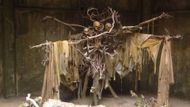Men with broken pasts and murder shrouded in symbols no one wanted to decipher. That's the universe True Detective immersed us in back in 2014, setting a new standard for crime television. Created by Nic Pizzolatto, the series took the detective show and injected it with Southern Gothic horror, philosophy, and outright existential terror. Every season of True Detective is a beast in its own right, but Season One, featuring Matthew McConaughey as the troubled Rust Cohle and Woody Harrelson as Marty Hart, is still its gem.
Taking place in the desolate Louisiana backroads, True Detective follows Cohle and Hart for 17 years as they pursue a serial killer whose murders are drenched in ritual and mystery. What begins as a homicide case involving a dead woman quickly drags the detectives into a more complex thread of occult symbols, corruption at the highest echelons, and trauma that gradually devours them alive. The story leaps between timelines, leaving the audience as confused and fixated as the characters.
True Detective plunges into questions of the nature of evil, reality, and time itself. It taps into the realm of weird fiction, drawing dark influence from authors such as H.P. Lovecraft and Robert W. Chambers. It isn't so much about catching a murderer as it's about staring into the void and attempting not to go insane.
And at the heart of all that insanity is The Yellow King. He's never clearly seen, never clearly described, but his essence lurks in every shadow. Not just a creepy moniker whispered in darkness, the Yellow King is a reminder of a mythos of cosmic horror that draws from fear, madness, and the concept that some things are too great and ugly to ever properly comprehend.
What follows is an analysis of who—or what—the Yellow King actually is, where he originates, and how True Detective managed to take a little-known literary character and make him one of the most remembered symbols of evil on television today.
The Yellow King: Introduction and context in True Detective

The Yellow King's name is first heard in Episode 2 of Season One True Detective, and from there on, he hangs over everything like a ghost that will not leave. Written in notebooks, half-whispered by traumatized witnesses, and knotted around grotesque imagery, the Yellow King is not a part of the case—he is the case.
Detectives Rust Cohle and Marty Hart encounter this eerie figure during an investigation of the murder of Dora Lange, whose body is found posed ritualistically: antlers on her head, strange stick effigies that form a circular pattern around her, and symbols older than the police can understand. As they burrow deeper, they start to see patterns—spirals carved into trees, mysterious references to "Carcosa," and whispers of the Yellow King from victims and cultists alike.
But the Yellow King is not a typical villain. He's not a man they can go track down and arrest. His name becomes a shorthand for something much bigger, something worse—a symbol of a huge, invisible web of corruption, violence, and insanity.
In True Detective, the Yellow King is real and unreal at the same time. He's the killer who is among us, but also a legend that gets stuck in the head. He's one thing that people discuss to account for the horror, but at the same time, an evasion of facing it head-on.
By the time the truth starts to unravel, the Yellow King has already caused his harm, not merely to the victims, but to detectives chasing him.
So, who is the Yellow King in True Detective?
The grand unveiling occurs late in True Detective Episodes 7 and 8, when we get to see Errol Childress, a deranged and deeply sinister fellow living in plain sight. He is no supernatural creature, but he might as well be. Scars on his face, a disturbed mind, and an icy demeanor make Childress the face of the evil Rust and Marty have pursued all season.
Turns out he's a member of the influential Tuttle family—a surname that's come up during the course of the investigation—and he's been operating in the background as the ruthless thug for a cult that's been performing ritual abuse and homicide for generations.
The cult has branches running all the way up through Louisiana's religious and political hierarchy. So, it's not so much a story about a single killer—it's about an entire system designed to cover for him.
Childress resides within a decaying plantation deep in the forest—a Stygian location he refers to as "Carcosa," replete with bones, distorted art, and the whispers of the atrocities he's committed.
In the climactic confrontation, Rust and Marty pursue him there, crawling through a hellish maze while Childress rambles on about the Yellow King and other abominations that sound barely human.
But even when Childress dies, the mystery's not completely solved. True Detective never tells us for sure if he's really the Yellow King, or merely some broken-down guy playing dress-up in a myth older and darker than anybody knows. That's the genius of it.
True Detective doesn't provide you with tidy answers—only more profound questions. The show leaves it open, reminding us that some secrets remain just beyond grasp, and that some monsters are scarier because they exist.
The mythology behind the name: Literary and symbolic origins

The Yellow King is not merely a spooky moniker thrown into True Detective for spice; it's a richly freighted allusion with a long history in horror fiction. To truly understand what the show is up to, you need to turn the clock back to 1895, when Robert W. Chambers released The King in Yellow, a collection of weird fiction that's had a subtle impact on generations of horror authors.
So what's The King in Yellow?
Chambers' novel consists of short stories interconnected by a fictional play. Supposedly, anyone who reads it loses their grip on reality. Characters become insane, time and space collapse, and a sinister figure called the King in Yellow begins appearing in visions.
The King himself is never adequately described. He's this ghostly figure associated with decay, madness, and a city called Carcosa, which appears to be beyond the bounds of regular space and time. There's also this thing known as the Yellow Sign—a mystical symbol that behaves like a mental virus. Once you've seen it, it gets under your skin and refuses to leave.
A couple of decades later, H.P. Lovecraft took up the torch. He incorporated aspects of Chambers' mythology—such as Carcosa and the Yellow King—into his own unknowable horrors. In Lovecraft's take on things, the King in Yellow emerges as a sort of cosmic being, connected to such beings as Hastur and the notorious Cthulhu. The central concept is unchanged: this character is not only terrifying—he embodies chaos, madness, and the notion that reality is tenuous and easily defiled.
How True Detective deploys it
In True Detective, these allusions aren't merely Easter eggs—they inform the whole mood. Carcosa is the term for the rundown shack where the killer lives. The spiral glyph carved into the victims relates back to the Yellow Sign. Even the script borrows from Chambers' cursed poetry:
"Along the shore the cloud waves break / The twin suns sink behind the lake…"
By incorporating these references, True Detective adds another level to its horror. Sure, there's a serial killer. Sure, there's a cult. But the atmosphere of the series—this nagging feeling that something larger and more sinister is hiding just beyond comprehension—comes directly from Chambers and Lovecraft.
Whether or not the Yellow King is "real" in a supernatural sense is left unanswered. True Detective leaves things ambiguous intentionally. Are the cultists simply employing horrific mythological monikers to excuse their atrocities? Or is there more, something old and decaying, propelling it all?
True Detective never makes you entirely certain. The horror operates on two levels—what is happening in the world, and what may be happening outside of it. And the Yellow King resides at the very center of both.
The Yellow King as a social and psychological metaphor

Alright, so we've established how the Yellow King relates to gory old horror tales, but in True Detective, he's a whole lot more than a title of a gory old horror tale. The show employs him as a metaphor—a representation of how things come undone, both in society and in people's heads.
The Yellow King is not some boogeyman in the woods. He's something so much larger: the manner in which corruption insinuates itself into all the nooks and crannies of society. In True Detective, the cult responsible for the killings isn't comprised of strange crazies; it consists of influential politicians, religious leaders, and wealthy elites who, through their influence, get away with unspeakable atrocities.
Critics have noted how this concept relates to what's referred to as "social entropy"—sophisticated jargon for the fact that order is breaking down and chaos is encroaching.
On a personal note, Yellow King also represents the mental cost of confronting such darkness. Consider what the detectives experience: they're not merely following leads—they're descending into a rabbit hole that plays tricks on their minds.
Rust Cohle, in particular, begins to disintegrate as he gazes too long into the void. His profound, dark philosophy and unsettling hallucinations make it difficult to distinguish between genius and insanity.
True Detective cuts back and forth between past and present, making time seem slippery. In 17 years, the case begins to resemble less a puzzle and more an endless loop. That notion—"Time is a flat circle"—is Cohle's statement that evil is not disappearing. It's baked into the human condition.
